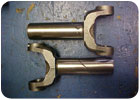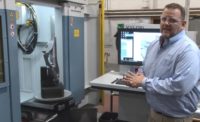
By far the biggest and most consistent users of NDT inspection have been the military and the aerospace industry, closely followed by manufacturers and users of pipelines and pressure vessels. In the past, general industry has not been as aware of the need for such inspection, especially the advantages of using independent NDT lab services.
This view was expressed in the November 2004 issue of Quality Magazine by Kirk Thams, vice president of operations at XRI Testing, a division of X-Ray Industries Inc., (Troy, MI). "We haven't done a good job of being out there and explaining what the different methods are, and how they can assist the different manufacturing processes," he says.
But with increased manufacturing technologies and the demands for uniform quality exerted by such initiatives as just-in-time, lean manufacturing, and ISO 9000, more and more companies are seeing the need for NDT inspection and quality certification by independent services.

Not just putting out fires
Earlier this year Thams said many NDT laboratory services are making a welcome transition-from supplying manufacturers' needs for overflow services to providing full programs of NDT inspection. "We're not just standing tall like Red Adair, waiting for the firebell to ring," he says. The reference was to Red Adair, the world's most experienced and best known oil well fireman, credited with tackling more than 2,000 incidents both on land and offshore, and subject of the 1968 John Wayne movie, "The Hellfighters."Like Adair's company, and firefighters everywhere, independent NDT labs have sometimes faced periods of relative inactivity, waiting for their customers to experience an emergency or an overload of inspection needs.

Lang says the primaries put pressure on their suppliers to provide advanced technological testing. These suppliers often find it more economical to contract those services, than to invest in new technology that does not contribute to their core competencies.

Outsourcing NDT operations
This was the case with Doncasters Medical Technologies (Oregon City, OR), which recently turned over its NDT program to XRI. "It's just a matter of cash utilization," says Chris Andersen, general manager of the facility. "To begin with, we don't have enough NDT work to support a full-time Level III NDT Examiner."He believes the independent lab could do a more efficient job and better address validation concerns, because that is its core competency. "It's a better use of our available funds to invest in new manufacturing equipment than to buy new inspection technology," he adds.
Even some large manufacturers, who have traditionally had extensive NDT services as an integral part of their own quality programs, are discovering benefits in contracting out their NDT services to independent labs.
Some manufacturers have found advantages in focusing on their core competencies while avoiding the inherent internal pressure to overlook marginal defects or weaknesses. They rely instead on the increased objectivity to be had by making use of an independent third party.
In so doing, these manufacturers often enjoy the benefits of advanced technologies and discoveries that they might not have invested in, unless they contract with a service that has already made that investment and done the research. Independent labs, especially smaller ones, can sometimes exhibit a versatility and agility in embracing change that is difficult for large, established industries.

Impartial third-party inspection
Moreover, primary manufacturers in some cases are putting pressure on their suppliers to recognize the value of a third-party review of their product quality. There is an increasing awareness of the value of NDT in preventive maintenance, as well as its use in the early stages of manufacturing, to detect problems in the process, rather than finding flaws in the final product.In this way, they can prevent expensive scrap and rework, allowing the quality department to focus on engineering quality-rather than detecting the lack of it-and demonstrating Philip Crosby's maxim that "Quality is free."
Preventive maintenance applies not only to in-house manufacturing, but also to field work, according to Larry Lang. An extensive component of an independent laboratory's business is routine inspection of pipes, pressure vessels and bridges.
By detecting problems early, before there's a crisis-for example, corrosion inspection in pulp and paper mills-the lab's customers realize prolonged use of their equipment and decreased downtime. "Even when they find flaws or stress weakness," says Lang, "by detecting them early, they can repair or replace sections of components and avoid expensive general shut-downs."
NDT lab services are beginning to make the transition from being mere overflow businesses, hoping their potential customers will be overwhelmed with their inspection needs, to the status of full-program providers. Many managers are gaining a new awareness of NDT inspection, not as a "necessary evil" or an inconvenience, but as a normal and valued part of doing business.

Hedge against interrupted services
Ron Siegrist, general manager at Westpro Labs (Salem, OR), points out another concern. "I have encountered large corporate entities, who have NDE capacity, but have considered continued auxiliary use of an independent lab as a hedge against union strikes, long-term equipment breakdowns, plant maintenance shutdowns and equipment upgrade shutdowns."Siegrist adds that some companies have simply determined they do not want to shoulder the burden of product quality as it relates to NDE-hence the use of an independent lab. But the transition to new technologies is seldom easy. Besides the cost of establishing new equipment and training, the independent lab must take the risk of not being accepted, or of finding that it's not cost-effective. A number of hurdles must be overcome.
Take the task of persuading a potential customer to switch from traditional film radiography to digital or CT. "There's a market evaluation that takes time," Lang says. "First, we need the customer's acceptance that the new technology will do what film has done. Does it meet the performance requirements?
"Next, is there a cost reduction? Will removing the cost of film and chemicals and the time involved offset the investment in new equipment, training and general ramp-up costs? Is there a significant technological advantage? Can we demonstrate that advantage in terms of having data easily reviewed and retrieved in electronic form?"
A major consideration is archival cost and convenience. "One DVD will hold 80 views, as against 80 to 240 pieces of 14 by 17-inch film for data analysis," Lang says. "And because the data is stored and transported electronically, we can share information concurrently with customers across the country or around the world."
A sometimes-underappreciated aspect of new technologies is the increased ability and ease of training. At first it seems counterintuitive to imagine that a new technology is easier to learn, but as with virtually every automated process, there are fewer ancillary details for the operator or inspector to concern himself with.
Thus an inspector can spend more time and concentration on inspecting, rather than processing film or worrying about film density on a penetrameter, for example. The customer must be assured of equal or enhanced performance, a net reduction in cost, technical advantages and improved archival ability. In short, will the service be better, quicker and less costly?

Dealing with risk management
As with any innovation, someone has to take a risk. It's difficult to invest in a service before you have customers for it and it's difficult to sell a customer on a service that hasn't yet been built. In some cases manufacturers have partnered with independent labs to invest in new equipment, sharing the burden of trying out new concepts.But small, specialized independent labs appear to be best suited for pursuing these goals. They exhibit their versatility in many ways. "One of our labs has 1,500 different customers," Thams says, "each requiring different methods, standards and specific needs."
To demonstrate the range of services provided, Lang described a typical day for some inspectors, citing actual recent experiences: "You might be called on to inspect an antique airplane being reconstructed by a hobbyist collector, a clutch actuator housing for an F-22 fighter or a propulsion manifold for the shuttle rocket.
"We even got a call from the Curator of the Oregon Museum of Science and Industry wanting X-ray images digitized to show the evolution of electronic circuit boards. But the strangest call of all was from the Portland Zoo, asking us to make a radiograph of an elephant's ankle."
Although independent labs can be more flexible and versatile, some labs will specialize in certain areas.
Thus one lab might concentrate on radiographic inspection of foundry castings, while another lab in another part of the country might do most of its business in construction sites, power generation plants or bridges.
"On a recent trip to Texas," Lang says, "I encountered over 70 NDT services in that state alone, because of all the petroleum production, refining and transportation. Because they are so varied, these labs are constantly looking for new and better ways to bring about superior testing and improved quality."
Their focus is on NDT inspection, not just "getting parts out the door." And though there is intense competition, as in all industry, professionals constantly work together to improve and enhance their ability to serve industry and the public by professional associations like the American Society for Nondestructive Testing, and the annual Digital Imaging Conference (Foxwoods, CT). It's here users and manufacturers of NDT equipment can share their needs and the latest developments in meeting those needs.
